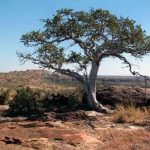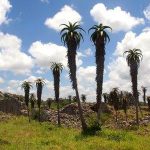TREE LIFE
August 1997
MASHONALAND CALENDAR
Saturday 2nd August: Botanic Garden Walk. We will meet Tom in the car park at 10.45 for 11a.m. This month Tom will show us the cycads in the Gardens. Lists will be available. There will be a guard for the cars.
August 8th to 12th: Seldomseen.
Sunday 17th August: Between Norton and Darwendale, along the shores of Lake Manyame, a portion of a farm belong to the Drummond family is being subdivided into plots and we have been invited to look at the vegetation along the ridge on some of the plots. The plan is to spend a short while there. The rest of the day will be spent at the old bridge that crosses the Manyame River, just about 3km further along the road.
Saturday 23rd August: The Hyde family will be away so Mark’s Botanic Walk is cancelled this month.
Tuesday 2nd September: Botanic Garden Walk. N.B. back to summer dates again.
October 2nd to October 5th: If there is sufficient interest we will have another trip to the Zambezi Valley staying at the RIFA camp. Please phone Maureen Silva-Jones (H – 740479, O – 755750) if you think you would like to be part of the group.
MATABELELAND CALENDAR
Sunday 3rd August: A morning only trip to the Luveve area. Please meet at the car park at Girls’ College at 8-8.30 a.m. for departure as soon as possible after that.
Sunday 7th September: All day visit to Esigodini – Colin and Judy Martin’s farm.
Friday 31st October to Sunday 2nd November.
Weekend trip to Gwaai Valley Safaris overlooking the Gwaai Valley.
Rates per person per night as follows: –
1) Basic use of campsite. $43.00 (no tents supplied)
2) Camp site with tents and beds $64.00
3) Self-catering lodges $128.00
The cut-off date for this visit is 6th October, please book now so that we can confirm our bookings.
A copy of Coates Palgrave’s Trees of Southern Africa is for sale for $250. If you are interested please write to: – Pat Walker, 4 Vail Close, Hillside, Bulawayo.
1st JUNE: TO HOW MINE.
On Sunday, 1st June 1997 some 9 stalwarts of the Bulawayo Branch set out for How Mine. As soon as we left the city boundaries, the narrow, potholed tarred road was transformed into a grand full tarmacadam thoroughfare. We journeyed along the crest of a rise. Wooded watercourses creased every fold of the hills that rolled away on either side, and we gained a vista of the distant Matobo Hills.
One small watercourse that we encountered and followed expanded into a very respectable river. How Mine has a beautiful club house where we met Noel Nichol who proved our most knowledgeable and interesting guide for the day.
We embarked on a good dirt road that wound its way dizzily to How Mine’s new dam. It meandered right round the same rolling hills we had viewed previously, but at their summits, and the views of the Matopos became awesome and more colourful.
Finally, we plunged abruptly down into an enormous scooped out area, where the imposing wall of the new dam towered over us. A herd of lazy cattle browsed or dozed by the side of the river.
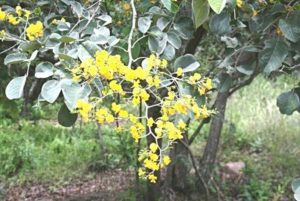
Pterocarpus rotundifolius. Photo: Mark Hyde. Source: Flora of Zimbabwe
We took a look at the vegetation that covered a nearby slope. The undergrowth was thick and rank and among it rose many Pterocarpus rotundifolius, some extremely small, very vicious Ziziphus mucronata and some tiny cheerful blossoms.
Eventually it was decided to wander by the river. This proved an interesting exercise. The banks of the stream were almost vertical, but we could hear it gurgling along.There were numerous poisonous plants such as Datura stramonium and Solanum sp. and thorny hazards such as Hibiscus cannabinus. The resident robins (Heuglin’s) were much upset by our intrusion into their territory and scolded constantly from the canopies of the Olive trees (Olea europaea subsp. africana).
There were numerous creepers and lianas, among them Cucumis anguria with its menacing-looking spines. Some fruit were still bright green, but the ripe yellow ones glistened in the morning sun, and the spines proved soft and yielding. After the recent record-breaking cold weather, the warming solar rays were welcome, and we were thankful to see and feel them.
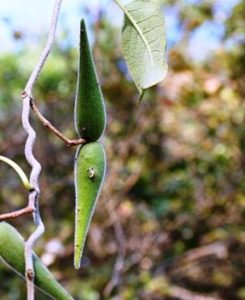
Tacazzea apiculata. Photo: Mark Hyde. Source: Flora of Zimbabwe
Cucumis metuliferus was also present and Angela found an asclepiad vine, Tacazzea apiculata, which bled white milk. A break was taken for tea and then Noel led us through a fascinating thicket to where the river could be forded. The stream flowed quite strongly at this point and was fairly wide, far too wide in fact to leap across. The water was crystal clear. It seeped through below the wall.
Helen and I decided we were no good at stepping-stones and while everybody else proceeded, we made our way back to the cars. Here we met Denis, who was kind enough, upon my request, to take us in his bakkie to the top of the wall. This substantial structure is most impressive. I should imagine it is over a hundred feet high, and at its base almost as wide. Grass has been planted on the downstream slope. The waterside is heavily metalled with rugged rock blocks, mostly banded ironstone. On one side the spillway has been blasted from solid rock. On the cliffs above it, Aloe chabaudii splashed its attractive pink inflorescences. The red and yellow spikes of Aloe cryptopoda echoed these bright colours. Just around the cliff corner these aloes threw themselves over and hung suspended against the dark stone.
Nature is quick to take advantage of a new habitat. The dam spans a poort at the confluence of two rivers and Dabchicks were paddling vigorously. They dived beneath the water with an audible ‘plop’ and it was fun to estimate where they would resurface. They bobbed up like tiny black corks and renewed their paddling. These smallest members of the Grebe family kept me fully absorbed and entertained for over half an hour.
There was also a small family party of Grey Hornbills in the trees on the opposite side of the wall to the aloes. Occasionally they swooped and dived, uttering their characteristic hoarse whistling calls, and also the warbling trill typical of this bird family.
Denis pointed out that the concrete mixer was electric, and closer inspection revealed the long flex that originated in a camp far below us.
We went to How Mine expressly to study the wild olive trees. Nowhere else have I seen them proliferate as they do here. The profusion ranges from tiny seedlings to girth giants that stand sentinel all along the river. Their foliage sparkled in the morning light and enabled one to pick them out from the other trees. Anthon found some fruit, miniature globules, green and brownish purple. I tasted one and enjoyed its brief flavour. It was the first time I had seen fruit on the wild olive, but a myriad of seedlings bore testimony to their presence. The delicate foliage soughs quietly in the wind, and enhances a stately, elegant tree.
Noel told us how many of these trees had to be felled where the rising waters will engulf them, but it is hoped to salvage the wood for carvings. Of course it is much in demand, especially overseas.
On the way down Helen expressed a desire to have a specimen of Combretum apiculatum for her collection. I thought I remembered where some of these trees were, but it turned out that they were all Combretum hereroense with very large leaves. But I am sure she found what she sought elsewhere.
We are indebted to Noel, and thank him most cordially for his friendly discourse and freely imparted expertise. We hope once again to visit this enchanting part of Matabeleland.
-Norma Hughes.
* P.S. from Anthon. ‘I did not find the fruiting tree along the stream bank; it was Angela Murray who very kindly showed it to me and helped me collect numerous ripe fruits. This find was most exciting for me as I have often seen this species of tree in green fruit but have never had the good fortune or time to return to collect ripe fruit. I look forward to trying to grow this beautiful tree from seed for the first time.’
NGOMOKURIRA, CHINAMORA COMMUNAL LAND, 15 June 1997
A good number of members gathered for the walk along a stream running in a valley below the giant granite bulk of Ngomakurira. As one would expect in this locally high rainfall area, the stream was still running and the sound of the water was extremely pleasant. It was a very warm day for the time of the year and the coolness of the riverine vegetation was most welcome.
This area of the Chinamora Communal land is an outlier of the Eastern Districts with locally high rainfall and botanically there are a number of species which suggest this.
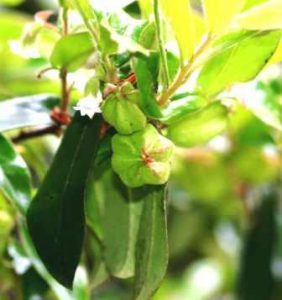
Diospyros whyteana. Photo: Bart Wursten. Source: Flora of Zimbabwe
One was Diospyros whyteana, which was seen on the recce but not on the day. Another is a sub-shrubby plant Clutia hirsuta that is very common in this area. It grows all over Wedza, another outlier. The Syzygium (was it Syzygium guineense ssp. afromontanum?) and the Oxyanthus speciosus, both of which were quite frequent along the stream, are also, I believe evidence of this.
Another feature of Communal Lands is their high weed content and this was most obvious in the area near the road (a fine colony of Silver-leaf, Desmodium uncinatum) and in the riverine fringe, which was a mass of Ageratum conyzoides. Ricinus communis, the Castor-oil Plant and Guava were also quite common. At the furthest point on the morning walk the path came down to a shady crossing of the stream and nearby were the stout, prickly, flourishing stems of the Mauritius Thorn, Caesalpinea decapetala. A very fine specimen of the Peanut-butter Cassia (Senna didymobotrya) was also present and it was agreed that the flowers and buds do smell somewhat of Peanut butter.
Climbing to great heights in the trees was Mondia whitei, which one suspects is an introduction. It is certainly very common around Harare – often occurring spontaneously in gardens and accepted as a garden plant.
Solanum mauritianum seems to do the same – does anyone ever deliberately plant these two? It has opposite leaves, milky juice, frilly stipule-like structures and large paired pendulous fruits.
After a short walk through some Brachystegia/Uapaca woodland at the start of the morning walk, we crossed a bare rocky area with dried-up seepage zones and characteristic plants such as Euphorbia matabelensis (some in flower), Brachystegia glaucescens and its hybrid with Brachystegia spiciformis, Margaritaria discoidea and Tapiphyllum velutinum, with its red underbark correctly showing through the cracks. Among the herbs, the grass-like sedge, Coleochloa setifera and the dried up fern-ally Selaginella dregei were plentiful.
By the river, Myrsine africana was common. We also saw the climber, Mussaenda arcuata, with its handsome yellow flowers. This is closely related to the handkerchief bushes of gardens (which belong either to Mussaenda or Pseudomussaenda) and indeed this particular plant also had the white expanded calyx lobes – which I had not realised occurred in the wild plant.
Also just up from the river was a small Sterculia quinqueloba. A debate took place over the Monotes, which turned out to be Monotes engleri.
After what seemed a longish morning walk – it was hot and the bush was full of burs –Triumfetta species and the usual Heteropogon/Aristida seeds were prominent – it was a pleasure to return to the cars for lunch. In the afternoon, we walked on the other side of the road along the base of the bare granite opposite Ngomakurira. The going was a bit harder as at first there was no path. After a while an interesting rocky area was found which yielded some new species, namely Rothmannia fischeri, Englerophytum magalismontanum and Diospyros natalensis.
In the final climb up the hill, with Father Ross and Rob Burrett, we saw some nice specimens of Aloe cameronii.
Thanks to Andy for leading the walk and for so much interesting information.
All in all, a most enjoyable day, which showed how much there is to see in the Chinamora CL so close to Harare.
-Mark Hyde
A WAY TO BEAT THE COLD.
On Sunday, the 6th of July, a cold wind was blowing into western Zimbabwe from the Drakensberg, but that did not deter the Bulawayo “tree people” from their scheduled revisit to the Mbalabala Ranch Nature Reserve. However, we did feel occasionally that we were a curiosity to the many people who were travelling the main road from Bulawayo to the border at Beitbridge as we climbed among the kopjies and warmed ourselves with cups of hot tea at the roadside.
We were joined on our day-long walk for the first time by Tessa Ball, who used to live and participate in Tree Society activities in Harare. We certainly welcome her to Bulawayo and hope to see her often. Her knowledge of the trees is much appreciated.
Anthon again led the group and this time he promised not to get carried away (lost) with the wide selection of species of trees and shrubs. Our focus was on the kopjies and a stream valley on the opposite side of the main road from where we walked in March. The climbing was pretty strenuous in the cold, but a few of the group managed to make it to the top of at least one kopjie. Tessa was by far the most energetic and climbed to the summit of the highest kopjie. In addition to the groves of stately lovely Brachystegia glaucescens that are a feature of this nature reserve, we saw Bridelia mollis, Rhus pyroides, Grewia monticola, and many more including 3 Albizia, Albizia amara, Albizia tanganyicensis and Albizia versicolor, Antidesma venosum, Crossopteryx febrifuga, and Olax dissitiflora.
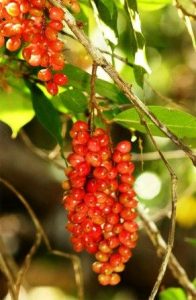
Antidesma venosum. Photo: Bart Wursten. Source: Flora of Zimbabwe
We also traded “barks” with a large family of baboons who obviously did not feel happy about our trespassing on their territory.
After lunch, observed curiously by passing pedestrians and motorists, we ducked through the barbed wire fence and revisited our March stamping grounds. Anthon seemed pleased to see a few of the rarer species still standing and looking healthy. I found the most interesting find of the day to be a Commiphora marlothii that was growing straight at 2-3 metres in a rock crevice on top of a large boulder. We should probably check on it periodically to see how it is doing.
In the course of the day we found a total of 110 species of trees and shrubs, including a number that do not appear on the Matabeleland tree card. They were mostly shrubs and sub shrubs, but one tree of particular note which does not seem to have been recorded from the west of Zimbabwe – Tricalysia niamniamensis.
According to the meteorologists, the temperature high for the day was 11ºC, but climbing around the kopjies kept us active and warm. A lesson was reinforced that it is better to spend this kind of day doing something interesting and satisfying than dwelling on the discomfort of being cold.
-Helen Hall.
SLUG CATERPILLARS – MAKWE CAVE AREA.
A visit to the Makwe Cave area in late January provided an unexpected interest in the form of numerous little and large green slug caterpillars. These were everywhere under the Msasa trees and are a feature in Miombo woodland together with other interesting caterpillars and moths.
The moths have two generations a year and emerge in October and November. The colour varies between sexes and can be dull greens greys, yellowish or red. Followed by the second generation in February. Some of the caterpillars were probably ready to pupate but the diversity of size was indicative of different larval stages. Most were not feeding but moving in search of food.
The Msasa trees were very denuded of leaves and there was a gentle sound of falling rain which was the dropping of faeces. Some of the faecal material was in bundles of web and is referred to as frass.
The caterpillars belong to a family of tree moths of the family Limacodidae and three species of the genus Latoia commonly occur in Africa and are, Latoia latistriga, Latoia johannes and Latoia vivida. Cheryl Haxen took a caterpillar to an entomologist who thought it might belong to the species Latoia urda (Duce). It would only be possible to tell once the immature form had bred out to the adult moth.
The slug moth caterpillars get their name because their legs are not apparent and they appear to move in a gliding sliding motion. On picking up a large specimen of about 30mm to examine the muscular contractions and fluid-like motion in what were pseudo-legs, a painful sting was inflicted along the index finger from a line of iridescent blue spines. The spines break off causing irritation and children who are tempted to play with the caterpillars and who are allergic to the poison have to visit doctors or dermatologists. The caterpillar is most colourful and is fascinating because it flows along and does not gallop, loop or move like other caterpillars. A great temptation for a young and enquiring mind.
The caterpillars are green and hence the name vivida in the one species. The sides of the body bear clusters of spines and resemble short tassels all around the edge of a rug. A pair of black dots with white borders is on each segment. Except on the third and eighth segment. The three thoracic segments have a bright red line along each side. The textbooks describe a light blue dorsal line of spines but the specimen under field investigation had two lateral lines of beautiful iridescent midnight-blue spines. The painful encounter with the colourful little captive recommends more discretion and there was not the same response to a pencil run along the sides of the body. These blue spines were not readily visible.
Each spine is hollow and terminates in a short sharp point which can and does penetrate the skin if the caterpillar is roughly handled. At the end of each spine is a tiny poison gland.
The caterpillars pupate by forming a rough hairy oval cocoon. The adult moths emerge in three weeks. Our arrival at the Makwe Cave area was at the time the caterpillars would have been seeking a suitable twig on which to entwine their pupal case.
The moths of this genus are small about 30mm and stubby with pale green forewings bearing a brown margin at the base. The hind wings are cream or light brown in colour. The adult moth has no proboscis and does not feed. Its function is reproduction and dispersal.
The eggs are laid like tiles on the undersides of a leaf of the food plant. In some cases over wintering is done by the adult who hibernates and lays in early spring.
The slug moth should not be confused with the Msasa moth.
–Mary Toet.
TREES AND OTHER PLANTS OF DAVID LIVINGSTONE’S ZAMBEZI EXPEDITION 1858-1863
Continued from Tree Life No 209 July 1997.
PALMYRA: 9 January 1859: “Palmyra 75 ft. long, 19 inches in diameter at two feet from the ground, 21 in. at bulb.”
10 August 1859: “Got three palmyra trees, the cutting up of which into small pieces detained us till 1 p.m. and they steamed us for three miles or to about a mile short of Shupunga house.”
The first of these two journal entries was written on the Shire and the second on the lower Zambezi. Palmyra is the name for Borassus flabellifer from India and Sri Lanka, and it seems clear that the Palmyra measured by Livingstone on 9 January 1859 was Borassus aethiopum, because of his separate diameter measurement of the “bulb” or typical swelling about halfway up the stem of the species. What is not clear is whether his other references to Palmyra and palm trees should be interpreted as Borassus aethiopum or Hyphaene benguellensis, or both. For example, on 6 August 1859, in the Zambezi delta he wrote, “Went by a southern channel to cut wood. Palm trees not dry.”
But what is clear is that Thomas Baines’ paintings of palm trees seen on the Zambezi expedition are more referable to Hyphaene than to Borassus.
PANGIRE: 10 October in a letter to Thomas Maclear: “Then there is the Pangire, a capital wood for shipbuilding…”
Livingstone attempted to reach Lake Malawi via the Rovuma River, which, he had been told, drained the lake from the north, and this letter was written at the mouth of the Rovuma on his return from the abortive trip. The Rovuma today forms the boundary between Mozambique and Tanzania, but it does not drain Lake Malawi.
Pangire is one of the vernacular names used in Mozambique for Millettia stuhlmannii, better known as panga-panga. The species occurs sporadically at low altitudes along most of Zimbabwe’s eastern border, but few trees reach the sizes that were common in Mozambique at one time.
PEAS: 14 February 1859, in an enclosure by Kirk to Livingstone’s Dispatch no. 13:
“Nowhere on the Zambezi have I seen so much cultivation. Maize, yams…. peas of various sorts….”
Kirk reported in much detail on the crops he saw cultivated in the Shire Valley, and he may well have seen garden peas, Pisum sativum, which would have been introduced by Arabs or Portuguese.
-Lyn Mullin To be continued.
ANDY MACNAUGHTAN CHAIRMAN


